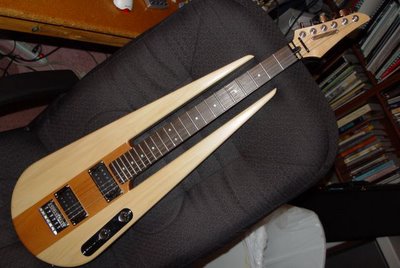 I'm eagerly awaiting the completion of my Jerry Rockwell solid-body electric. In the meantime, my dad made this for me!
I'm eagerly awaiting the completion of my Jerry Rockwell solid-body electric. In the meantime, my dad made this for me!MP3 Audio Sample 1.65MB
I wanted a project me and my dad could work on. I also needed some kind of solid-body instrument that could be had cheap, quick, and easy. I called my dad and he was up for it. He traded some work to a guy he knew for a Yamaha solid-body.
We thought about converting it to 3-string and pulling frets but it was going to take time and money. I suggested we convert the guitar to something in the neighborhood of a dulcimer for development purposes. I didn’t even know if I would be comfortable playing it. I just figured it was the beginning of a long journey.
Dad cut the sides off and added what you see in the picture. Jerry Rockwell suggested stringing it up like a dulcimer so that the highest tuned string would be closest to my belly. He also recommended string gauges for tuning it to DADADD. (from bass to melody, 6-string equidistant) Dad took it to a guy in town who put in a left-handed nut and set it up for the requested gauges. He also checked my dad’s wiring and corrected a few things.
I've been very busy lately working on my business and DVD lessons. I pretty much forgot he was working on it. When he brought it to the house recently, I couldn’t believe it. The sound was amazing. I immediately recorded the sample Blues-Hendrix-like piece above.
I took my dad's electric to Unicoi to show it off. I also jammed with an 84-year-old Chet-Atkins-like guitar player. (One of the most amazing experiences of my life) Other than that, I’ve been way too busy to play this thing.
The little I have played it has been a blast. Surprisingly, I’ve gotten used to the close string spacing. Crosspicking with the right hand is cleaner and the non-thumb chord fingerings are easier. It only took a few times to get used to it. It's very comfortable to hold and use.
It’s like having a 4-string equidistant dulcimer tuned DADD (like Schnaufer’s early fingerpicking – also like Lorraine Lee, Bonny Carrol, Juanita Baker, Leo Kretzner, etc…) but with two lower strings as well. I like to think of it as being a bass dulcimer and regular dulcimer combined. One of the first things to understand is you don’t need to strum all six strings all the time.
Notice the neck is not even two octaves long. Trust me when I say there’s already plenty of notes to deal with. If it was only three strings, I’d want more frets and length. I’ve basically got all the notes a guitarist has minus the highest two.
I’ve always marked my chromatics at 1+, 3, 4, 5, and 7. The way I introduce the scale to people is:
1) Open melody string.
2) Next two notes come by straddling the first dot.
3) Follow the next three dots for 3, 4, and 5.
4) The next two unmarked spaces are 6 and 6+.
5) The last dot marks 7.
Except for straddling the 1.5 mark, it’s pretty straight forward. By always marking chromatics like this, I can tune banjoes, guitars, and basses to some form of DAD and I’m right at home. (Except for the strings being on backwards) I’m still very open to other marking schemes but this is my favorite.
I’m always thinking regular dulcimer frets with the pluses as apposed to thinking guitar fret numbers. I’ve dabbled with thinking of them as guitar frets but haven’t made the switch. I think a good book of chromatic tabs might include both systems.
An inexpensive effects device is arriving in the mail today that should make the cool sounds more portable. So far, I’ve been using the effects that are included in my Roland VS-1680 recorder.
Jerry Rockwell’s 3 or 4-string diatonic electric solid-body is supposed to be ready by Christmas. Check out Jerry’s progress at www.jcrmusic.com/wp_blog/?cat=4. When I bring Jerry’s dulcimer to a festival near you, you’ve got to give it a try. Just ask.
I’ll definitely have both electrics with me at KMW winter weekend. Having the two instruments should give me the tools I need to function inside and outside of the dulcimer community in any imaginable capacity.
Take Care,
Stephen
0 Comments:
Post a Comment
<< Home